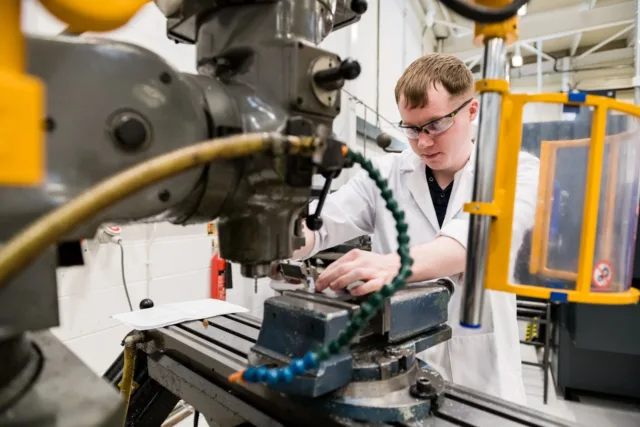Courses
Mechanical Analysis and Automation
Certificate
Course Details
| Course Code | SG_EMECH_S06 |
|---|---|
| Level | 6 |
| Duration | 1 year |
| Credits | 30 |
| Method of Delivery | Online |
| Campus Locations | Sligo |
| Mode of Delivery | Part Time |

Course Overview
The Certificate in Mechanical Analysis and Automation is a one-year 6 subject (30 credit) part-time course which runs over two semesters. It is a minor award at level 6. The course covers introductory engineering mathematics, fundamental mechanics, CAD and automation.
This programme is designed as a qualifier to allow holders of craft qualifications and others with substantial relevant work experience to progress to the Level 7 BEng in Precision Engineering and Design (online). With the skills and knowledge developed, the Level 7 programme can then be completed with a further two years of online study.
Course Details
Year 1
| Semester | Module Details | Credits | Mandatory / Elective |
|---|---|---|---|
| 1 |
Introduction to Engineering MathematicsThis module prepares the student for progression onto the degree level 7 mathematics. It reintroduces the ideas of differentiation from the basics up to partial differentiation and integration from the basics up to integration by parts. It also covers formula manipulation, the factor theorem, partial fractions and complex numbers. The course is designed so that real life situations are used to demonstrate where the techniques are used. Learning Outcomes 1. Be able to manipulate mathematical equations 2. Be able to graph linear, quadratic, exponential, log and trig functions 3. Use the factor theorem and remainder theorem 4. Find partial fractions 5. Differentiate using thechain rule, product ruleand quotient rule, findthe maxima and minima of functions 6. perform parametric, implicit differentiation and partial differentiation 7. perform integration by substitution and by parts 8. Calculate areas using integration 9. Apply De Moivre’s theorem to find the powers of complex numbers |
05 | Mandatory |
| 1 |
Pneumatic / Electro-Pneumatic and Hydraulic Systems Full-TimeThis module will give the students an introduction to pneumatic/electro pneumatic and hydraulic systems.It will cover basic pneumatic and hydraulic components and their use in complete systems. The student will also become acquainted with standard pneumatic and hydraulic symbols in accordance with IEC standards and be able to use a software simulation package to draw and simulate practical circuits. This module will also cover advanced pneumatic and electro pneumatic circuits including sequencing of pneumatic cylinders. The circuits will be build and simulated in software. Learning Outcomes 1. Describe the components of a compressed air and air treatment system. 2. Demonstrate an understanding of pneumatic circuit operation, including sequence control. 3. Apply the cascade method to solve pneumatic sequentialproblems involvingcascade groups andcylinders. 4. Demonstrate an understanding ofbasic hydraulic systems. 5. Design and simulate electro-pneumatic circuits to sequence cylinders. 6. Employ formulae to calculate flow rate, piston force, system pressure and piston size. |
05 | Mandatory |
| 1 |
Introduction to Engineering MechanicsThe student will learn to define the standard units of measurement, forces, power, and work. The student will be able to add forces, determine forces due to friction, use moment of forces and the principle of moments to solve for forces in beams. The student will be able to break forces into their components. The student will learn how to calculate the position of the centre of gravity and centroid of area for various shapes. The student will learn the relationship between stress, strain and Youngs modulus and use the realtionship and factor of safety to solve simple design problems. The student will also learn how to use the linear and angular laws of motion. This module is jointly taught by a number of lecturers and includes many examples of how mechanics is used in real life situations Learning Outcomes 1. Define and manipulate the standard units of measurement used in mechanics, and explain the relationship between mass, weightand force, and explain the concepts of work, power and efficiancy |
05 | Mandatory |
| 2 |
Intermediate Engineering MechanicsThe student will determine stress in materials used in compound bars. The student will perform calcualtions involving shear stress, shear strain, and poisson's ratio. The student will draw shear force and bending moment diagrams. The student will calculate stress in thin walled pressure vessels, and thin rotating rings. The student will make calculations involving torsion. The student will do calculations involving thermal strain.. This module is jointly taught by a number of lecturers and includes many examples of how mechanics is used in real life situations Learning Outcomes 1. Calculate stresses in each material of a compound bar. |
05 | Mandatory |
| 2 |
Computer Aided Design and ModellingThis module provides the candidates with the skills and knowledge of current standards in Engineering Drawing and Computer Aided Design. The candidates will be capable of generating 3D solid models of engineering related components and assemblies within a commercially available CAD package and will have the necessary skills to communicate effectively with society and other professional engineers. Students will be introduced to a range of modelling features and apply them in the design and modelling of such components. Learning Outcomes 1. Demonstrate the ability to sketch and illustrate engineering components. 3. Use a solid modelling CAD system to create 3D models of parts and assemblies for common engineering devices found in the manufacturing industry. 4. Produce detailed partand assembly drawings of engineering parts, products and devices, in an efficient and conventional manner. 5. Apply CAD concepts and skills to communicate design intent for a single manufacturing related device, consisting of a number of parts. |
05 | Mandatory |
| 2 |
Automation ProgrammingIn this module students will be introduced to the concept of PLCs and their implementation in automation systems. Students will learn how to program brick type and modular PLCs and learn PLC relevant concepts of signal processing. . Learning Outcomes 1. Apply sequential function chart (aka Grafcet or state-transition) methods to control sequential processes including selective and parallel branching techniques. 3. Produce ladder logic to solve electro-pneumatic sequential problems involving the use of two cylinders. 4. Employspecific addressing configuration of an industry standard PLC and apply same to practical automation problems. 5. Create ladder logic to solve industrial problems using timers, counters and flip flops. 6. Demonstrate an understanding of structured text programming. |
05 | Mandatory |
Recommended Study Hours per week
Examination and Assessment
Note: Where assessment on the programme involves examinations, these are held on campus or at another exam venue in the Republic of Ireland. There are typically two exam periods: January and May. Times scheduled for examinations (face to face / online exams ) are in GMT.
Students who are resident overseas and those with extenuating circumstances may apply to take examinations online with an external online invigilation service (online proctored exams), where this is available. Places are limited for this service.
On-Campus Attendance Requirement
Note: Check programme Examination and Assessment requirements, as they may involve examinations to be taken on campus.
Progression
Completion of this programme forms part of the entry requirements for the B,Eng. (Online) In Precision Engineering & Design .
Download a prospectus
Entry Requirements
Applicants should have or be undertaking an apprenticeship in toolmaking or in a mechanical trade.
Consideration will also be given to applicants who have substantial (in excess of three years) experience working in technician-type roles in industry.
Frequently Asked Questions
1. I am a qualified toolmaker or fitter. Can I access the programme?
You are qualified to enter the programme.
2. I have been working as a production/machine/CNC operator (or similar). Can I access the programme?
If you have at least three years experience working in a technician type role, you may be able to access this programme. Applications of this nature will be considered individually.
Applicants with other qualifications and with relevant work experience may also be considered through ATU Sligo’s Recognised Prior Learning (RPL) process. RPL is a process that may allow you to gain admission to a programme or to receive exemptions / credit from some parts of a programme based on demonstrated learning that you may have achieved through another programme of study or through your work and career. Further information is available through www.atu.ie/recognition-of-prior-learning which our dedicated RPL portal or by contacting our admissions team at admissions.sligo@atu.ie.
Careers
Graduates will be equipped to progress onto the final stages of the L7 BEng in Precision Engineering and subsequently be employed as technicians/associate engineers in precision engineering, toolmaking, automation, medical device manufacturing, polymer processing, pharmaceutical/bio-pharma, ICT Hardware, and general mechanical and manufacturing engineering companies.
Further Information
Who Should Apply?
This programme is designed as a qualifier to allow holders of craft qualifications and others with substantial relevant work experience to progress to the Level 7 BEng in Precision Engineering and Design.
Application Closing Date
Start Date
Contact Information
Admissions Office
T: +353 (0) 71 931 8511
E: admissions.sligo@atu.ie
Online Student Advisor
Natalie McNulty
T:+353 (0) 71 930 5429
E: natalie.mcnulty@atu.ie
Mechanical & Manufacturing Engineering


